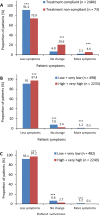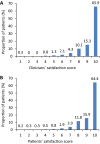Correlation of Objective Endpoints and Subjective Patient-Reported Outcomes in NAFLD Treatment with Essential Phospholipids: Real-World Data Based on Pooled Analysis of Observational Studies
- PMID: 33993460
- PMCID: PMC8123926
- DOI: 10.1007/s40801-021-00250-x
Correlation of Objective Endpoints and Subjective Patient-Reported Outcomes in NAFLD Treatment with Essential Phospholipids: Real-World Data Based on Pooled Analysis of Observational Studies
Abstract
Background: While no "gold-standard" pharmacotherapy for nonalcoholic fatty liver disease (NAFLD) is yet established, essential phospholipids (EPLs) are reported to decrease steatosis and improve laboratory parameters.
Objective: This analysis evaluated adherence and satisfaction with EPL treatment as patient-reported outcomes and their relationship with changes in laboratory and ultrasound parameters among Russian patients with NAFLD.
Methods: Data were pooled from three observational Russian studies-MANPOWER (2015-2016), LIDER 1 (2012-2013), and LIDER 2 (2013)-in which EPLs were used for at least 12 weeks in the treatment of liver diseases and which measured both subjective and objective endpoints. Only patients who had NAFLD were included in this analysis. The main endpoints were to determine treatment adherence and satisfaction with 12 weeks of EPL therapy, relationship between adherence/satisfaction and changes in the laboratory and ultrasound parameters. A secondary subgroup analysis was performed to identify patients with NAFLD who responded better (or worse) to 24 weeks of adjunctive EPL treatment.
Results: Overall, 3384 patients were included. A total of 82.2% of patients were adherent to 12 weeks of EPL treatment; high/very high satisfaction was reported by 15.3%/65.9% of clinicians and 15.9%/64.4% of patients. There was positive correlation between patients' adherence and satisfaction and significant improvement in laboratory (transaminases, lipid profile; p < 0.001) and ultrasound (steatosis, p < 0.001) parameters, and improvement in symptoms (p < 0.001) after 24 weeks of EPL. Male patients, patients with unhealthy lifestyles, and those with more comorbidities showed a better response in laboratory and ultrasound parameters.
Conclusions: Patients with NAFLD treated with adjunctive EPL therapy in real-world clinical practice in Russia showed good treatment adherence and treatment satisfaction. Improvements in laboratory and ultrasound parameters, as well as dynamics of patient symptoms, were positively correlated with adherence and satisfaction.
Plain language summary
Nonalcoholic fatty liver disease (NAFLD) is a major cause of liver disease, and patients have a risk of liver cancer and needing transplantation. Patients with advanced NAFLD are usually recommended to use medication. Clinical trials in patients with NAFLD showed that essential phospholipids (EPLs) comprising phosphatidylcholine improved liver fat accumulation (known as steatosis), so treatment guidelines in several countries recommend they be added to the usual therapy. EPLs have been associated with both objective and subjective improvements. This real-world study evaluated three observational studies to assess how patient adherence and satisfaction with EPL treatment were related to changes in clinical parameters in 3384 Russian patients with NAFLD. Overall, 82.2% of patients were adherent with 12 weeks of EPL therapy, and almost two-thirds of patients (64.4%) and clinicians (65.9%) reported very high satisfaction with treatment. Patients’ adherence and satisfaction increased alongside significant improvements in liver enzymes, lipid levels, liver fat content (steatosis), and fewer symptoms after 24 weeks of EPL therapy. Male patients, those with an unhealthy lifestyle, and those with other comorbid conditions had the best response to EPL therapy. This study shows that Russian patients with NAFLD have good adherence and satisfaction with EPL therapy in routine clinical practice and highlights the importance of adherence to EPL therapy in these patients.
© 2021. The Author(s).
Conflict of interest statement
K.S. is a Sanofi employee. VTI, MVM, ENS, IVM, AAS, EIS, and LKP have no conflicts of interest that are directly relevant to the content of this article.
Figures



Similar articles
-
Essential phospholipids as a supportive adjunct in the management of patients with NAFLD.Arab J Gastroenterol. 2015 Sep-Dec;16(3-4):99-104. doi: 10.1016/j.ajg.2015.09.001. Epub 2015 Nov 14. Arab J Gastroenterol. 2015. PMID: 26589371 Clinical Trial.
-
Effectiveness of phosphatidylcholine in alleviating steatosis in patients with non-alcoholic fatty liver disease and cardiometabolic comorbidities (MANPOWER study).BMJ Open Gastroenterol. 2020 Jan 13;7(1):e000341. doi: 10.1136/bmjgast-2019-000341. eCollection 2020. BMJ Open Gastroenterol. 2020. PMID: 32095253 Free PMC article.
-
Effectiveness of phosphatidylcholine as adjunctive therapy in improving liver function tests in patients with non-alcoholic fatty liver disease and metabolic comorbidities: real-life observational study from Russia.BMJ Open Gastroenterol. 2020 Mar 26;7(1):e000368. doi: 10.1136/bmjgast-2019-000368. eCollection 2020. BMJ Open Gastroenterol. 2020. PMID: 32337059 Free PMC article.
-
Evaluations of Lifestyle, Dietary, and Pharmacologic Treatments for Pediatric Nonalcoholic Fatty Liver Disease: A Systematic Review.Clin Gastroenterol Hepatol. 2019 Jul;17(8):1457-1476.e7. doi: 10.1016/j.cgh.2018.05.023. Epub 2018 May 29. Clin Gastroenterol Hepatol. 2019. PMID: 29857146
-
Nonalcoholic fatty liver disease and nonalcoholic steatohepatitis: new trends and role of ultrasonography.J Med Ultrason (2001). 2020 Oct;47(4):511-520. doi: 10.1007/s10396-020-01058-y. Epub 2020 Oct 21. J Med Ultrason (2001). 2020. PMID: 33089412 Review.
Cited by
-
Effect of essential phospholipids on hepatic steatosis in metabolic dysfunction-associated steatotic liver disease associated with type 2 diabetes mellitus and/or hyperlipidemia and/or obesity: study protocol of a randomized, double-blind, phase IV clinical trial.Trials. 2024 Jun 11;25(1):374. doi: 10.1186/s13063-024-08208-4. Trials. 2024. PMID: 38858768 Free PMC article.
References
-
- Ivashkin VT, Drapkina OM, Mayev IV, Trukhmanov AS, Blinov DV, Palgova LK, et al. Prevalence of non-alcoholic fatty liver disease in out-patients of the Russian Federation: DIREG 2 study results. Russ J Gastroenterol Hepatol Coloproctol. 2015;25(6):31–41.
LinkOut - more resources
Full Text Sources
Other Literature Sources

